Health
Care
Indicator 25 Health Care Expenditures
Indicator 26 Components of Health Care Expenditures
Indicator 27 Out-of-Pocket Health Care Expenditures
Indicator 28 Access to Health Care
Indicator 29 Use of Health Care Services
Indicator 30 Nursing Home Utilization
Indicator 31 Home Care
Indicator
25 - Health
Care Expenditures
Health care can be a major expense for older Americans,
especially for individuals with limited income who have a chronic condition or
disability. Expenditures on health care include the cost of physicians’
services, hospitalizations, home health care, nursing home care, medications,
and any other goods and services used in the treatment or prevention of disease.

- In
1996, the average annual expenditure on health care was $5,864 among persons
ages 65 to 69, compared with $9,414 among persons ages 75 to 79, and $16,465
among persons age 85 or older.
- In
1996, older Americans living in institutions incurred $38,906 in annual
health care expenditures on average, compared with $6,360 among older
persons living in the community. Nursing home care accounted for 64 percent
of the total expenditures of the institutional population.
- Between
1992 and 1996 there was a slight increase in average annual health care
expenditures among older Americans in every age category.
- In
a given year, health care expenditures tend to be concentrated among a
relatively small group of individuals. In 1996, 1 percent of Medicare
beneficiaries age 65 or older incurred 13 percent of the health care
expenditures in that age group. The top 5 percent of enrollees with the
highest expenditures incurred 37 percent of all health care expenditures.
Data
for this indicator can be found in Tables 25a, 25b, 25c, and 25d.
Indicator
26 - Components of Health Care Expenditures
Health
care expenditures can be broken down into different types of goods and services.
The amount of money older Americans spend on health care and the type of health
care that they receive provide an indication of the health status and needs of
older Americans in different age and income groups.
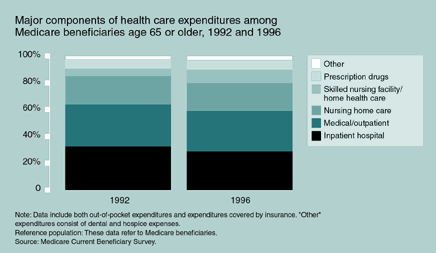
- The
percentage of health care expenditures spent on inpatient hospital care
declined from 33 percent in 1992 to 29 percent in 1996. Expenditures on
skilled nursing facility care and home health care increased from 6 percent
to 10 percent over the same period, and prescription drug expenditures
remained stable, at approximately 7 percent.
- In
1996, about 46 percent of health care expenditures among persons age 85 or
older went to nursing home care, compared with 7 percent among persons ages
65 to 69. Expenditures on skilled nursing facility care and home health care
were also higher among persons age 85 or older. Older Americans under age 85
spent proportionately more money on inpatient hospital services,
medical/outpatient services, and prescription drugs, although their absolute
expenditure levels for these services were lower than those of persons age
85 or older.
- Patterns
of health care expenditures also varied by income level. Persons age 65 or
older in the bottom fifth of the income distribution incurred
proportionately higher expenditures for nursing home and skilled nursing
facility or home health care, compared with higher-income individuals. In
contrast, older Americans with lower income incurred proportionately lower
expenditures for medical/outpatient services and prescription drugs.
- In
1996, about 69 percent of all noninstitutionalized Medicare beneficiaries
had prescription drug coverage through an HMO, Medicaid eligibility, a
private Medicare supplement, or other sources.
Beneficiaries who did not have prescription drug coverage had lower
total drug expenditures (out-of-pocket expenses and expenses covered by
insurance combined) than beneficiaries who had coverage. However,
out-of-pocket expenditures for prescription drugs were 83 percent higher for
beneficiaries who lacked coverage, on average, than for those who had drug
coverage.[35]
Data for this indicator can be found in Tables 26a and
26b.
Indicator
27 - Out-of-Pocket
Health Care Expenditures
The
proportion of out-of-pocket expenditures that is allocated to health care indicates
the burden placed on older persons by health care expenses. Data on
out-of-pocket health care expenditures by income level provide information on
how this burden varies for households with different financial resources.

- In
1998, annual out-of-pocket expenditures on health care—which include
expenditures on health insurance, medical services and supplies, and
prescription drugs—ranged from 9 percent to 16 percent of total
expenditures among households headed by older persons at different levels of
income.
- Average
dollar expenditures on health care increase with income. In 1998, households
headed by older persons in the bottom fifth of the income distribution spent
an average of $1,654 per year on health care, compared with $3,614 among
households in the top fifth of the income distribution.
- Although
dollar expenditures increase with income, the relative burden of health care
costs is much higher among lower-income households and households in the
middle of the income distribution. In 1998, households in the bottom fifth
spent an average of 13 percent of their expenditures on health care. Those
in the middle fifth spent an average of 16 percent, and those in the top
fifth spent 9 percent.
- Over
the past decade, the share of out-of-pocket expenditures spent by the older
population on health care increased slightly for all income groups.
Data
for this indicator can be found in Table 27.
Access to health care is determined by a variety of
factors related to the cost, quality, and availability of health care services.
Over 96 percent of older Americans are covered by Medicare, which provides
affordable coverage for most acute health care services. However, health care
users also require a reliable source of care that is provided without major
inconvenience.
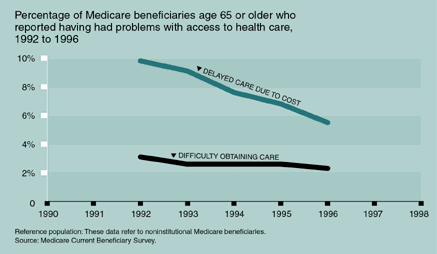
- In
1996, only 2 percent of Medicare enrollees reported difficulty in obtaining
health care, down from 3 percent in 1992. The percentage of Medicare
enrollees who reported that they delayed using health care because of cost
declined from 10 percent in 1992 to 6 percent in 1996.
- In
1996, about 7 percent of persons ages 65 to 74 reported delays in obtaining
health care due to cost, compared with 5 percent of persons ages 75 to 84,
and 3 percent of persons age 85 or older.
- Access
to health care varied by race. In 1996, the percentage of older Americans
who reported delays due to cost was highest among non-Hispanic black persons
(10 percent), followed by Hispanic persons (7 percent), and non-Hispanic
white persons (5 percent). About 2 percent of non-Hispanic white persons
reported difficulty in obtaining health care, compared with 4 percent of
non-Hispanic black persons and 3 percent of Hispanic persons.
Data
for this indicator can be found in Tables 28a and 28b.
Indicator
29 - Use
of Health Care Services
Most older Americans have access to health care through
Medicare. Medicare provides access to a variety of services, including inpatient
hospital care, physician care, outpatient care, home health care, and care at a
skilled nursing facility. However, the types of health care services that older
Americans receive under Medicare have changed over the past decade.
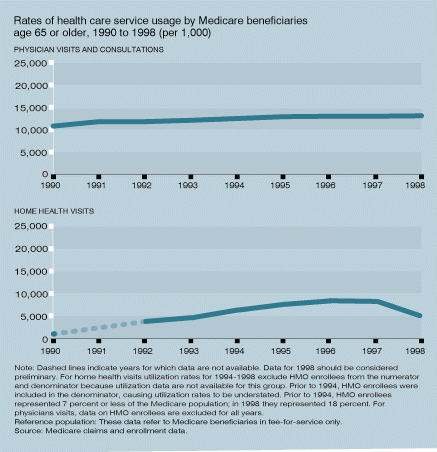
- Physician
visits and consultations increased from 10,800 per 1,000 beneficiaries in
1990 to 13,100 per 1,000 in 1998.
- Use
of home health services increased substantially from 2,141 home health
visits per 1,000 enrollees in 1990 to 8,227 visits per 1,000 in 1997. Home
health care use increased during this period in part because of an expansion
in the coverage criteria for the Medicare home health benefit.[36]
In 1998, home health visits from Medicare claims dropped to 5,058 per 1,000
beneficiaries, following implementation of the Balanced Budget Act, which
changed Medicare payment policies for home health care services.

- Between
1990 and 1998, there was a moderate increase in the hospitalization rate
from 307 hospitalizations per 1,000 Medicare enrollees in 1990 to 365 per
1,000 in 1998. Although the rate of hospital admissions increased, the
average length of hospital stay declined from 9 days in 1990 to 6 days in
1998. (Note: Readers should use caution in comparing these trends with those
shown on the facing page because of differences in the vertical scales.
Physician visits and consultations and home health visits are much more
common among persons age 65 or older than either hospitalizations or skilled
nursing facility admissions.)
- Skilled
nursing facility admissions also increased from 23 admissions per 1,000
enrollees in 1990 to 69 per 1,000 enrollees in 1998.
- Use
of home health care and skilled nursing facility care increased markedly
with age. In 1998, home health agencies made 2,350 home health visits per
1,000 enrollees ages 65 to 74, compared with 12,709 among persons age 85 or
older. Skilled nursing facility admissions per 1,000 were 27 for persons
ages 65 to 74 and 200 for persons age 85 or older.
Data
for this indicator can be found in Tables 29a and 29b.
Indicator
30 - Nursing
Home Utilization
Residence in a nursing home is an alternative to
long-term care provided in one’s home or in other community settings. Recent
declines in rates of nursing home residence may reflect broader changes in the
health care system affecting older Americans. Other forms of residential care
and services such as assisted living and home health care have become more
prevalent as rates of nursing home admissions have declined. Declines in
disability among the older population may also have contributed to this trend.
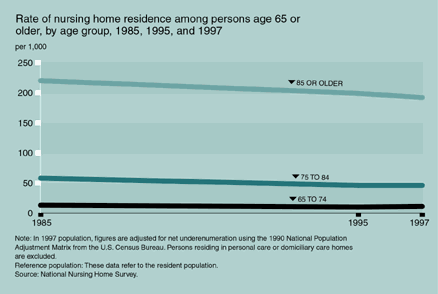
- In
1997, only 11 persons per 1,000 ages 65 to 74 resided in nursing homes,
compared with 46 per 1,000 persons ages 75 to 84 and 192 persons per 1,000
age 85 or older. About half of older nursing home residents in 1997 were age
85 or older.
- The
total rate of nursing home residence among the older population declined
between 1985 and 1997. In 1985, the age-adjusted nursing home residence rate
was 54 persons per 1,000 age 65 or older. By 1997 this rate had declined to
45 persons per 1,000. Among persons ages 65 to 74, rates declined by 14
percent, compared with a 21 percent decline among persons ages 75 to 84, and
a 13 percent decline among the population age 85 and older.
- Older
women at all ages had higher rates of nursing home residence than men. In
1997, three-fourths of the nursing home residents were women.
- Assisted-living
facilities can provide an alternative to long-term care in a nursing home. A
recent national study of assisted-living facilities found that there were
11,472 assisted-living facilities nationwide, accommodating 558,400
residents.[37] Assisted-living administrators estimated that 24
percent of their residents received assistance with three or more activities
of daily living, such as bathing, dressing, and mobility. They estimated
that about one-third of the residents had moderate to severe cognitive
impairment.[38]
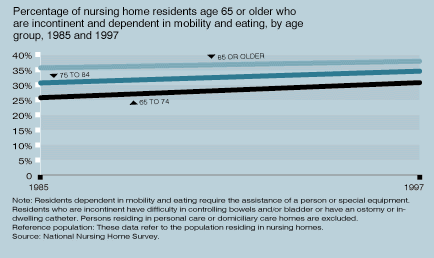
- Over
the past decade, there has been an increase in the percentage of nursing
home residents with functional limitations. Between 1985 and 1997, the
percentage of nursing home residents age 65 or older who were incontinent
increased from 55 percent to 65 percent, the percentage who were dependent
in eating increased from 41 percent to 45 percent, and the percentage who
were dependent in mobility increased from 76 percent to 79 percent. The
percentage who were limited in all three of these functions increased from
33 percent to 36 percent over this period.
- In
1997, the percentage of nursing home residents who were limited in all three
areas was higher among women (36 percent) than men (34 percent); however,
between 1985 and 1997, the increase in the percentage was greater among men
(20 percent) than among women (6 percent).
- Between
1985 and 1997 the increase in rates of functional limitation in all three
areas was also higher among nursing home residents ages 65 to 74 (19
percent) than among residents ages 75 to 84 (13 percent) or residents age 85
or older (6 percent).
Data
for this indicator can be found in Tables 30a, 30b, and 30c.
Although most long-term care spending in the United
States is for nursing home and other institutional care, the majority of older
persons with disabilities live in the community and receive assistance from
spouses, adult children, and other family members. Most of this care is informal
and unpaid, although there is an increasing number of older Americans with
disabilities who are relying on a combination of informal and formal long-term
care. The aging of the population will increase the demand for long-term care in
the community and raises important questions about who will provide this care
and how it will be financed.

- The
percentage of older Americans who received community-based care for a
disability declined from 18 percent in 1982 to 15 percent in 1994. This
occurred even though there was a slight increase in the number of older
Americans who received assistance (from 4.6 million to 4.7 million).
- Possible
reasons for the decline in long-term care in the community include
improvements in the health and disability of the older population, changes
in household living arrangements (e.g., the move toward assisted living and
other residential care alternatives), and greater use of special equipment
and assistive devices that help to maintain older disabled persons’
independence in the community.[39]
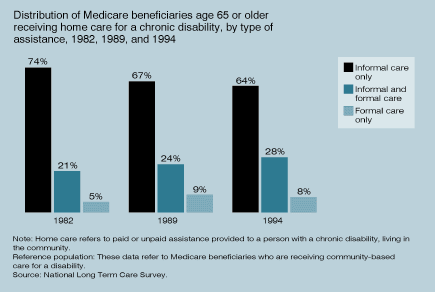
- Although
most of the home care received by older persons with disabilities is unpaid,
the use of informal care as an exclusive means of assistance is declining.
The percentage of older Americans with disabilities who received only
informal care declined from 74 percent in 1982 to 64 percent in 1994, while
the percentage of older persons who received both informal and formal care
increased from 21 percent to 28 percent over this period.
- The
increase in the use of a combination of informal and formal services was
greatest among older Americans with the most severe disabilities.[40]
- The
increase in the use of paid care may reflect changes in the health of the
older population, increases in the financial resources of older Americans,
greater preference to supplement health care with formal services, and
programmatic changes in Medicare (e.g., liberalization of coverage rules
under the home health benefit) and Medicaid (e.g., expansion of home and
community-based services).[41]
Data
for this indicator can be found in Tables 31a and 31b.
Contacts:











